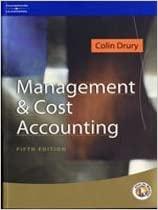Question
I have Two Problems which are both solved below. My question is what makes the approach of solving in each one not the same. Why
I have Two Problems which are both solved below. My question is what makes the approach of solving in each one not the same. Why does one calculation include avoidable traceable cost while the other doesn't?



2nd Problem:



(2400000)= segment margin lost 1800000=savings in traceable fix cost due to discontinuation of beta 765000=Additional contribution margin
*West Region has Traceable costs that should be avoidable according to segment statement

so again why for the Diego company problem, 250000 in avoidable Traceable Fix Cost not calculated in answer?
Diego Company manufactures one product that is sold for $80 per unit in two geographic regions -the East and West regions. The following information pertains to the company's first year of operations in which it produced 40,000 units and sold 35,000 units. Variable costs per unit: Manufacturing Direct materials Direct labor ....... Variable manufacturing overhead..... Variable selling and administrative ..., Fixed costs per year: Fixed manufacturing overhead ... Fixed selling and administrative expense....... $24 $14 $2 $4 $800,000 $496,000 The company sold 25,000 units in the East region and 10,000 units in the West region. It determined that $250,000 of its fixed selling and administrative expense is traceable to the West region, $150.000 is traceable to the East region, and the remaining $96.000 is a common fixed expense. The company will continue to incur the total amount of its fixed manufacturing overhead costs as long as it continues to produce any amount of its only product Required: Answer each question independently based on the original data unless instructed otherwise. You do not need to prepare a segmented income statement until question 13 14. Diego is considering eliminating the West region because an internally generated report suggests the region's total gross margin in the first year of operations was $50,000 less than its traceable fixed selling and administrative expenses. Diego believes that if it drops the West region, the East region's sales will grow by 5% in Year 2. Using the contribution approach for analyzing segment profitability and assuming all else remains constant in Year 2, what would be the profit impact of dropping the West region in Year 2? Calculation of changes in profit (if west region Is dropped): It is given that the forgone segment margin of west region is $110,000 and calculated additional contribution margin is $45.000 Now, calculate the changes in profit: Forgone segment margin of west region Changes in profit + Additional contribution margin = ($110,000) +S45,000 =($65,000) Hence, the calculated change in profit is (S65,000) Comment Cane Company manufactures two products called Alpha and Beta that sell for $120 and $80, respectively. Each product uses only one type of raw material that costs $6 per pound. The company has the capacity to annually produce 100 000 units of each product. Its average cost per unit for each product at this level of activity are given below 20 Alpha Beta Direct materials.. $ 30 $12 Direct labor. Variable manufacturing overhead Traceable fixed manufacturing overhead Variable selling expenses Common fixed expenses Total cost per unit $ 100 The company considers its traceable fixed manufacturing overhead to be avoidable, whereas its common fixed expenses are unavoidable and have been allocated to products based on sales dollars 15 8. Assume that Cane normally produces and sells 60,000 Betas and 80,000 Alphas per year. If Cane discontinues the Beta product line, its sales representatives could increase sales of Alpha by 15,000 units What is the financial advantage (disadvantage) of discontinuing the Beta product line? (8) Determine the increase or decrease in profits: Calculation of A company contribution margin: It is given that the total unit of Ais 15,000 units and contribution margin per unit is $51 ($120 - $69) The total contribution margin for A would be calculated by multiplying the total units of B with the contribution margin per unit as below A Company (Total unit of AxContribution margin per unit) contribution margin =15,000 units x S51 = $765,000 Hence, the A Company contribution margin is $765,000 Comments (2) Step 13 of 20 A Calculation of change in B Company net operating income It is given that the contribution margin (if the B product is dropped) is ($2.400.000) traceable fixed manufacturing overhead is $765,000, and calculated traceable fixed manufacturing overhead is $1,800,000. The change in B Company net operating income is the sum of contribution margin, traceable fixed manufacturing overheads of A and B. Contribution margin Change in B company = +Traceable fixed manufacturing overhead net operating income +Traceable fixed manufacturing overhead = ($2,400,000) + S765,000 +S1,800,000 = $165,000 Hence, the increase in net income in B product are dropped by $165,000 val 5 - 12 NOE 25000 East 10,000 West Besian Sales CM Company 2,800000 1540.000 12.60900 400000 86 doo o O0O. 900,000 73 toooh 200 0000 10000 90000.0 50000 750000 800 000 440 000 360deo 250 000 110ooo -TFC SM - CHE FS4A: I LOSS WN. F w 244 25000 = 600.000 14 x 35.000 = 350 000 2 x 25000 = 50000 4 7 25000 100000 Vs Goodo 24 X 10000= 240.000 4 X 10.000 140.0bo 2x10.000 - 200.00 4X10000 = 40000 440.000 (110000) ooooo Sale inc x 45 45000 Additional Contribution 45000 =Profit will increase by this amantStep by Step Solution
There are 3 Steps involved in it
Step: 1

Get Instant Access to Expert-Tailored Solutions
See step-by-step solutions with expert insights and AI powered tools for academic success
Step: 2

Step: 3

Ace Your Homework with AI
Get the answers you need in no time with our AI-driven, step-by-step assistance
Get Started


